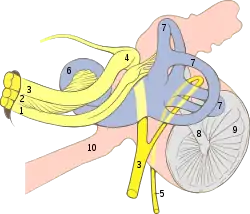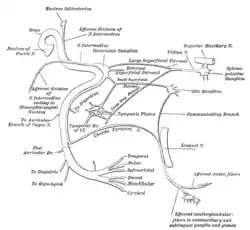Geniculate ganglion
The geniculate ganglion (from Latin genu, for "knee"[1]) is a collection of pseudounipolar sensory neurons of the facial nerve located in the facial canal of the head. It receives fibers from the facial nerve. It sends fibers that supply the lacrimal glands, submandibular glands, sublingual glands, tongue, palate, pharynx, external auditory meatus, stapedius muscle, posterior belly of the digastric muscle, stylohyoid muscle, and muscles of facial expression.
| Geniculate ganglion genu structure like form | |
|---|---|
 The course and connections of the facial nerve in the temporal bone. | |
 Cranial nerves VII and VIII and selected structures of the inner and middle ear. 1 Nervus vestibularis, 2 Nervus cochlearis, 3 Nervus intermediofacialis, 4 Ganglion geniculi, 5 Chorda tympani, 6 Cochlea, 7 Ductus semicirculares, 8 Malleus, 9 Membrana tympani, 10 Tuba auditiva | |
| Details | |
| Innervates | lacrimal glands, submandibular glands, sublingual glands, tongue, palate, pharynx, external auditory meatus, stapedius muscle, posterior belly of the digastric muscle, stylohyoid muscle, muscles of facial expression |
| Identifiers | |
| Latin | ganglion geniculi nervi facialis |
| MeSH | D005830 |
| TA98 | A14.2.01.116 |
| TA2 | 6287 |
| FMA | 53414 |
| Anatomical terms of neuroanatomy | |
The geniculate ganglion is one of several ganglia of the head and neck. Like the others, it is a bilaterally distributed structure, with each side of the face having a geniculate ganglion.
Structure
The geniculate ganglion is located close to the internal auditory meatus.[2] It is covered superiorly by the petrous part of the temporal bone (which is sometimes absent over the ganglion).[3]
The geniculate ganglion receives fibers from the motor, sensory, and parasympathetic components of the facial nerve. It the contains special sensory neuronal cell bodies for taste, from fibers coming up from the tongue through the chorda tympani and from fibers coming up from the roof of the palate through the greater petrosal nerve.[4] Sensory and parasympathetic inputs are carried into the geniculate ganglion via the nervus intermedius. Motor fibers are carried via the facial nerve proper. The greater petrosal nerve, which carries preganglionic parasympathetic fibers, emerges from the anterior aspect of the ganglion.
The motor fibers of the facial nerve proper and parasympathetic fibers to the submandibular and pterygopalatine ganglia do not synapse in the geniculate ganglion. The afferent fibers carrying pain, temperature, and touch from the posterior auricular nerve, as well as those carrying special sensory (taste) fibers from the tongue (via the chorda tympani), do not synapse in the geniculate ganglion. Instead, the cells of the geniculate ganglion relay the signal to the appropriate brainstem nucleus, much like the Dorsal root ganglion neurons relay signal to nuclei in the spinal cord.[5]
Function
Via the geniculate ganglion, the facial nerve (CN VII) gives[6]
- parasympathetic innervation to:
- the lacrimal glands.
- the submandibular glands.
- the sublingual glands.
- special sensory innervation to:
- general sensory innervation to:
- skin of the posterior ear
- somatic (branchial) motor innervation to:
- the palate
- the pharynx.
- the external auditory meatus
- the stapedius muscle.
- the posterior belly of the digastric muscle.
- the stylohyoid muscle.
- muscles of facial expression.
Clinical significance
The geniculate ganglion is an important surgical landmark near the internal auditory meatus.[2]
The geniculate ganglion may become inflamed due to viral infection by herpes zoster virus.[8]
Additional images
 Plan of the facial and intermediate nerves and their communication with other nerves.
Plan of the facial and intermediate nerves and their communication with other nerves.
See also
References
- "genu-, geni-, gen- + (Latin: knee)". WordInfo. Retrieved 2008-10-03.
- Hall, George M.; Pulec, Jack L.; Rhoton, Albert L., Jr. (1 November 1969). "Geniculate Ganglion Anatomy for the Otologist". Archives of Otolaryngology. 90 (5): 568–571. doi:10.1001/archotol.1969.00770030570007. ISSN 0003-9977.
- Rhoton, Albert L.; Pulec, Jack L.; Hall, George M.; Boyd, Allen S. (1 January 1968). "Absence of Bone over the Geniculate Ganglion". Journal of Neurosurgery. 28 (1): 48–53. doi:10.3171/jns.1968.28.1.0048.
- M.J. Turlough FitzGerald; Gregory Gruener; Estomih Mtui (2012). Clinical neuroanatomy and neuroscience (6th ed.). Saunders/Elsevier. ISBN 978-0702037382.
- Moore, Keith L.; Dalley, Arthur F.; Agur, A. M. R. (2013-02-13). Clinically Oriented Anatomy. Lippincott Williams & Wilkins. ISBN 9781451119459.
- Agur., Anne M. R. Clinically Oriented Anatomy, 8e. Lippincott, Williams & Wilkins. ISBN 978-1-4963-4721-3. OCLC 1076750418.
- Boudreau, James C.; Sivakumar, Latha; Do, Ly Thi; White, Thomas D.; Oravec, Joseph; Hoang, Nga Kieu (1985). "Neurophysiology of geniculate ganglion (facial nerve) taste systems: species comparisons". Chemical Senses. 10 (1): 89–127. doi:10.1093/chemse/10.1.89. ISSN 0379-864X.
- Hunt, J. Ramsay (February 1907). "ON HERPETIC INFLAMMATIONS OF THE GENICULATE GANGLION. A NEW SYNDROME AND ITS COMPLICATIONS". The Journal of Nervous and Mental Disease. 34 (2): 73–96. ISSN 0022-3018.
External links
- cranialnerves at The Anatomy Lesson by Wesley Norman (Georgetown University) (VII)
- lesson3 at The Anatomy Lesson by Wesley Norman (Georgetown University) (midearcavity)